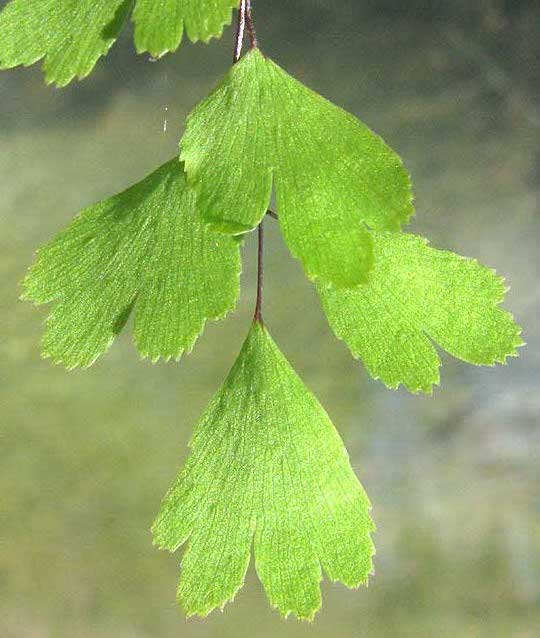Excerpts from Jim Conrad's
Naturalist Newsletter

from the October 21, 2012 Newsletter issued from the valley of the Dry Frio River in northern Uvalde County, southwestern Texas, on the southern border of the Edwards Plateau; elevation ~1750m (~5750 ft); N29.62°, W99.86°; USA
VENUS'S-HAIR FERN
In this arid country both mushrooms and ferns are uncommon, so when you spot one it's worth taking notice. This week as I waded upstream in the ankle-deep, very slippery-bottomed little Dry Frio River behind the cabin I found a fern. It grew in the dark shade of overhanging shrubs on a little limestone ledge at the water's edge about a yard (meter) above the water. The combination of dry limestone outcrop and high humidity just inches above the river's surface was just what this fern needed. You can see its dangling, three-times-pinnate fronds above. A close-up of individual leaflets, or pinnae, is shown below:

With the frond divided like that into so many individual segments, and the stem slender, brittle and very dark, you might recognize this as a kind of maidenhair fern -- as a member of the genus Adiantum. But about 200 maidenhair species are recognized, so which is this one?
In most of eastern North America, except for the US Deep South, the common maidenhair species is the Northern Maidenhair, which we profiled just a couple of months ago in Mississippi, shown at https://www.backyardnature.net/n/x/adiantum.htm.
Our Texas maidenhair's pinnae are not organized on long stems, or rachillas, like that species', but rather cascade like random confetti tumbling from the shadows. Our Texas species is the Venus's-Hair Fern, sometimes also called the Southern Maidenhair. It's ADIANTUM CAPILLUS-VENERIS, a species that craves moist limestone cliffs, banks, and ledges along streams and rivers, so we found it exactly in its favorite kind of haunt. Venus's-Hair Ferns are distributed from Amazonia in South America up through Central America and Mexico into the southern half of the US, from coast to coast, plus it's found in Eurasia and Africa.
No rigorous scientific studies support use of the Venus's-Hair Fern for medicinal purposes, but traditionally many cultures have regarded "teas" or syrups made from its leaves and roots as strong medicine. Many herbal stores -- which often market it as Avenca, a name from Brazil -- sell it for respiratory disorders, hair loss, gallstones, and to regulate menstruation. Certain Amazon tribes use it for the same reasons, and other societies have employed it to reduce cholesterol and blood pressure, lower blood sugar, to detoxify the body, and for other cures.